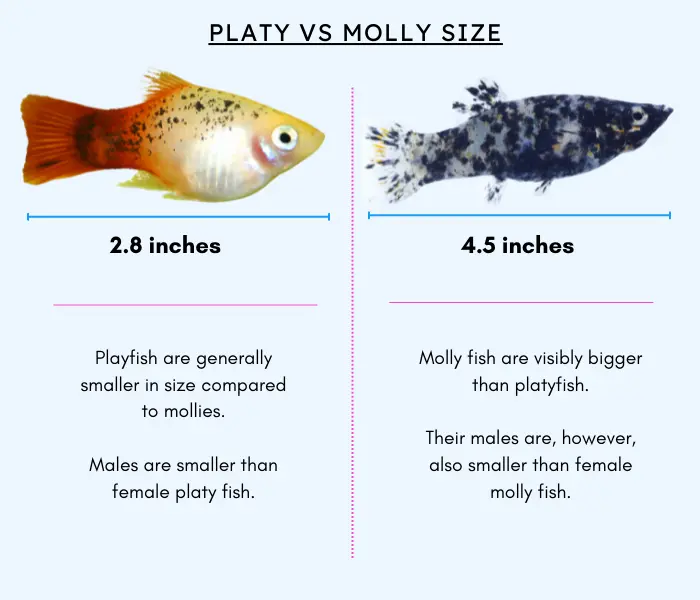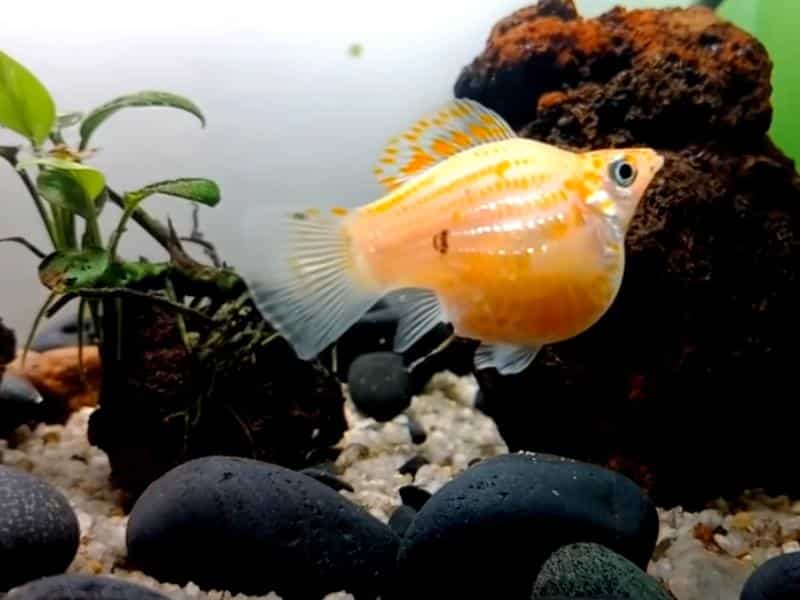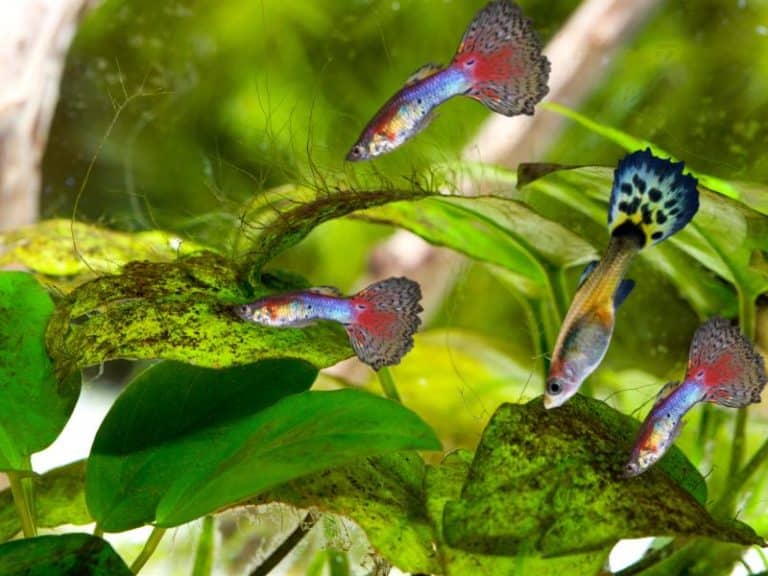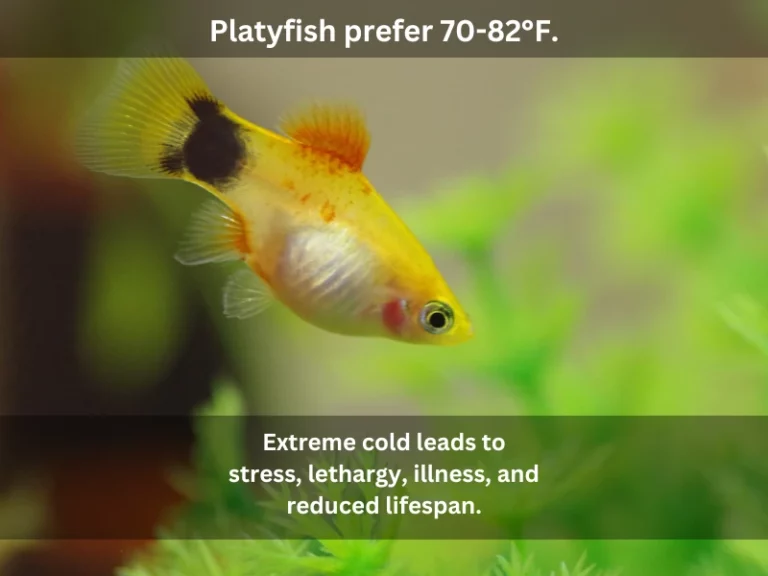Platyfish (Xiphophorus maculatus) and molly fish (Poecilia sphenops) are fairly similar in stature but differ. If you’re unsure which fish to keep in your aquarium, I’ve distinguished mollies from platies in this article to guide your choice. So, what’s the main difference between platyfish and mollies?
You can differentiate platies from mollies by size, shape, and color. Platyfish are stout and smaller in size – measuring about 2.5 inches, while mollies are elongated and bigger in size, averaging 4.5 inches long. Platies can be yellow-orange, white, or red, while mollies can be black, green, orange, or white.
Here’s a summary of the differences between platyfish and molly fish:
| Platy Fish | Molly Fish |
| Average size: 2-3 inches | Average size: 3-5 inches |
| Short and round bodies | Elongated and sleek bodies |
| Lifespan: 2-3 years | Lifespan: 3-5 years |
| Maturity: four months | Maturity: 3 months |
| Genus: Xiphophorus | Genus: Poecilia |
| pH: 6.8-8.3 | pH: 7.5-8.5 |
| Temperature: 72-82°F | Temperature: 72-80°F |
| Water hardness: 4-12 dGh | Water hardness: 12-30 dGh |
Platies vs. Mollies – Differences Explained
Though platies and mollies belong to the same Poeciliidae family of livebearing fish, they don’t share the same genus. The similarities between them make some people even want to breed platies and mollies. You can tell them apart by examining their size, body colors, and shape.
I’ve illustrated their differences below to help you tell mollies and platies apart.
Size
Although their fry are of the same size (¼-inch), adult mollies are larger than platies. However, as they mature, mollies become visibly bigger than platyfish.
The average size of an adult platy is 2.8 inches, while that of adult molly fish is 4.5 inches. In both species, females are slightly larger than males.
The average size of a male molly is about 3 inches. Females can grow larger to about 4-5 inches. On the other hand, a male platy’s average size is 2 inches, but females can grow up to 3 inches.

As you can see, mollies are generally larger than platies, which is a major differentiating factor if you have these in a community tank.
1. Colors
Mollies may exhibit green, white, and black colors while platies are mostly yellow-orange, white, or red. However, you cannot distinguish mollies from platies using body colors alone as they vary from type to type.
For instance, the gold red platyfish looks similar to the gold doubloon molly as they both have a golden coloration.
2. Body and mouth shape
If body color isn’t enough to distinguish these fish, you can also use physical features to find the difference.
You can tell a platy from a molly by looking at the shape of their mouths. The mouth of platy fish faces forward while that of molly fish faces upward. Mollies also have elongated bodies, medium-sized fins, and sleek bodies, while platies are shorter with small-sized fins and round bodies.
3. Lifespan
Platies and mollies are livebearers that give birth to their fry rather than laying eggs. The fry of a platyfish take about four months to mature and reach their full size, while molly fish fry mature faster for breeding within three months but can take up to four months to reach their full size.
Mollies also tend to have a longer lifespan compared to platies. They can live up to five years in the aquarium with the proper water conditions, while platies have a lifespan of 2-3 years living in aquariums.
4. Tank requirements
Now that you can tell the difference between platies and mollies, it is crucial to understand their varying care requirements (because they are not the same).
Platies prefer freshwater, but mollies can survive in various water conditions, including fresh, brackish, and saltwater.
Platies prefer water with a pH level of 6.8 to 8.3, a water hardness of 4-12 dGH, and a water temperature ranging from 72 to 82°F.
On the other hand, mollies thrive well in water with pH levels between 7.5 to 8.5, water hardness ranging from 12 to 30 dGH, and a water temperature between 72-80°F.
Both mollies and platies require water with zero ammonia/nitrite, and the nitrate level should be less than 30ppm. It is recommended to perform a 25% water cycle every week for both fish.
SEE ALSO: Platy Fish Tank Size Guide
Molly Profile

Mollies are freshwater fishes from the Mexican marine and brackish waters. They exhibit different colors and are popular among aquarists since they reproduce quickly, mature faster, and are easy to maintain.
General characteristics
Mollies are characterized by a mouth facing upwards and elongated bodies. Their bodies are usually thick-set, with most parts covered by spots. Mollies also have angular dorsal fins, flattened heads, and round convex edges.
The molly is diurnal (active during the day) and is social fish that love swimming in shoals.
Molly fish varieties
Mollies have different varieties distinguished by different colors and patterns. The three main molly fish breeds are:
- Common/Short-finned Molly (Poecilia sphenops): These are the smallest mollies, with males being 3 inches while females are 4-5 inches.
- Sailfin Molly (Poecilia latipinna): They have different color variations, including albino. The sailfin molly is about 4-5 inches.
- Mexican/Giant sailfin molly (Poecilia velifera): The giant sailfin can grow to 6 inches and has about 18 rays on its fins.
There are different types of molly fish bred from the above mollies. These include:
- Black mollies: These are heavy breeders with a completely black body
- Marble Lyretail mollies: Characterized by marbled black and white bodies
- Balloon mollies: Uniquely shaped like an inflated balloon.
- Lyretail mollies: They look like a lyre with the caudal fins having extended ends
- Golden mollies: These mollies exhibit a bright gold coloration.
Care requirements for mollies
The molly fish is omnivorous and, therefore, can feed on different food types. You should provide mollies with algae wafers or plant them in their tank. Give your mollies fish flakes, vegetables, and frozen/live feeds such as bloodworms and brine shrimp to provide the right nutrients.
Only provide feeds that the fish can finish within three minutes to avoid overfeeding and accumulation of ammonia.
Mollies prefer substrate consisting of rocks, sand, or pebbles. Keep four mollies in a 10-gallon tank.
Best tank mates
Mollies are among the most peaceful fish but might show aggression when overcrowded or mating. Therefore, it is best to keep one male and four females.
Due to their non-aggressive behavior, you can keep mollies with the following tank mates:
- Guppies
- Angelfish
- Tetras
- Gouramis
Platy fish profile
Platies are freshwater fish from the Poeciliidae family and Xiphophorus genus. They are native to southern Mexico and Central America. You can find different platy hybrids between the Southern, Variable, or Swordtail platy.
Some popular Southern platy breeds include half-moon, blue mirror, coral, and bleeding heart platy. Popular variable platies include marigold, redtail, and rainbow.
General characteristics
Platyfish are livebearers with various colors and patterns. They’re characterized by compact fins, compressed bodies, and fan-shaped tail fins. You can tell a male platy from a female platy by observing the fin shape.

The males have a pointed caudal fin called gonopodium, which is used for inserting sperms into the female platy. On the contrary, the female platy will have a fan-shaped anal fin.
Platyfish get pregnant quite often and can give birth to up to 40 fry after a gestation period of about 28-35 days.
Platyfish varieties
Due to the breeding of different platies, numerous platyfish varieties are characterized by different color patterns. Some of the most common types of platyfish include
- Salt and pepper platies: These exhibit bodies with spots (dark or light) spread all over their bodies.
- Tuxedo pattern: These platies have a combination of black and another color, such as red or gold.
- Wagtail pattern: In these fish, the dorsal and caudal fins are black while the rest of the body contains another coloration. Some of the most common colors are gold, red, blue, and green.
- Pintail variation: The fish is characterized by an elongated tail fin that resembles a pin.
There are other varieties of platyfish, such as the Hi-fin variation, comet, and rainbow pattern.
Platyfish are very active, but they love hiding in the tank. Therefore, it is ideal to have hiding places such as natural/artificial plants and decorative items in the tank.
Best tank mates
Platies are peaceful fish and can be kept with other fish species. However, the males may show aggression whenever a few females are in the tank.
Since platies are small-sized and peaceful, you should not keep them with large and aggressive fish that might attack/feed on them.
Small to medium-sized tank mates are okay.
Here are great tank mates for platyfish.
- Guppies
- Shrimps
- Mollies
- Swordtails
Note: Keep in mind that platies and mollies may not cross-breed under normal circumstances, even if you keep them in the same tank.
References
- U.S Department of Agriculture: Contrasting habitat use of diurnal and nocturnal fish assemblages in temperate Western Australia
- Robert H. Robbins: Sailfin Molly




